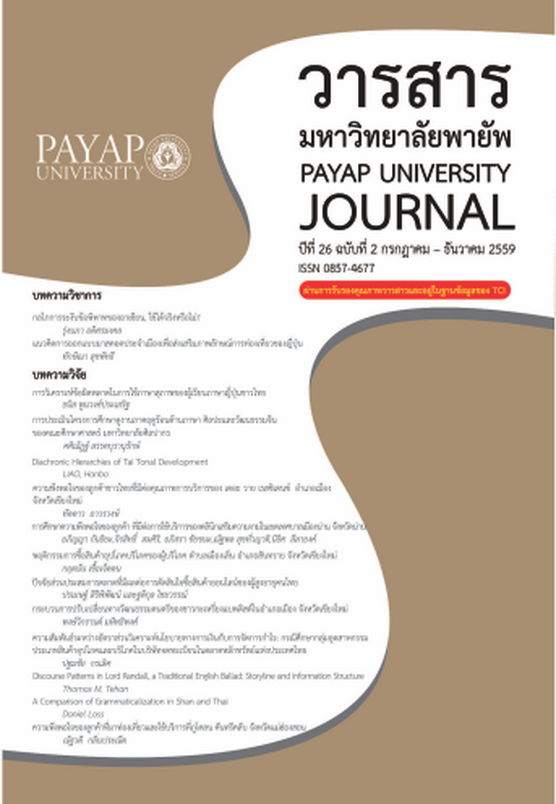A Comparison of Grammaticalization in Shan and Thai
Main Article Content
Abstract
The Thai language has been the subject of much grammaticalization research but, more information about grammaticalization in other Tai languages is needed. This study addresses this need, by investigating synchronic language corpora created to compare grammatical elements of Thai and Shan. The corpora for both languages were the result of a video elicitation method (Post 2007) that controlled the genre of the texts within the corpora. It was found that the possessive marker kʰɔ̌ɔŋ appears to be more deeply grammaticalized within Thai than Shan. Both languages were found to have similar frequencies for the multi-functional morpheme thîi. Differences in some verbal auxiliaries also imply different influences in respect to areal borrowing.
Article Details
How to Cite
Loss, D. (2017). A Comparison of Grammaticalization in Shan and Thai. PAYAP UNIVERSITY JOURNAL, 26(2), 203–216. https://doi.org/10.14456/pyuj.2016.15
Section
Research Articles
References
Bisang, W. (2004). Grammaticalization without coevolution of form and meaning: The case of tense-aspect modality in East and mainland Southeast Asia. In W. Bisang et al (Ed.) What makes grammaticalization?: a look from its fringes and its components (pp. 109-138). New York: Mounton de Gruyter.
Bisang, W. (2008). Grammaticalization and the areal factor the perspective of East and mainland Southeast Asian languages. In M. J. Lopez-Couso & E. Seoane (Ed.) Re thinking Grammaticalization. New Perspectives [Typological Studies in Language 76] (pp. 15-35). Amsterdam: John Benjamins.
Bybee, J. (2003). Mechanisms of Change in Grammaticalization: The Role of Frequecy. The handbook of historical linguistics/edited by Brian D. Joseph and Richard D. Janda. Oxford: Blackwell Publishing.
Chamniyom, R. (2003). A Study of Prepositions Converted from Verbs in Thai. Unpublished Master’s Thesis, Department of Thai, Silapakorn University: Bangkok.
Diller, A. (2001) . Grammaticalization and Tai linguistic change. In K. Tingsabadh & A. S. Abramson (Ed.) Essays in Tai linguistics (pp. 139-176). Bangkok: Chulalongkorn University Press.
Diller, A V. N., Edmondson, Jerold A. and Yongxian Luo. (2008). The Tai-Kadai languages New York: Routledge.
Enfield, N.J. (2004) . Areal Grammaticalization of Postverbal ‘Acquire’ in Mainland South east Asia. In S. Burusphat (Ed.), Proceedings of the 11th Southeast Asia Linguistics Society Meeting (pp. 275-296). Tempe: Arizona State University.
Heine, B. & Kuteva, T. (2004). World Lexicon of Grammaticalization. Cambridge: Cambridge University Press.
Hopper, P. L. & Traugott, E. C. (1993). Grammaticalization. Cambridge: Cambridge University Press.
Kullavanijaya, P. (2008). A Historical Study of /thîi/ in Thai. In A. Diller et al (Ed.) The Tai- Kadai languages. New York: Routledge.
Li, K.F. (1977). A Handbook of Comparative Tai. Honolulu: The University Press of Hawaii.
Lewis, M. P., Simons, G. F. and Fennig, C. D. (2015). Ethnologue: Languages of the World, Eighteenth edition. Dallas, Texas: SIL International.
Meesat, P. (1997). A study of auxiliary verbs developed from verbs in Thai. Unpublished Master’s Thesis, Department of Thai, Chulalongkorn University: Bangkok.
Pittayaporn, P. (2009). Proto-Southwestern-Tai Revised: A New Reconstruction. In P. Sidwell (Ed.) Journal of the Southeast Asian Linguistics Society. Vol.2 (pp. 119-143).
Post, M. W. (2007). Grammaticalization and compounding in Thai and Chinese: A text- frequency approach. In Studies in Language 31(1) (pp. 117-76). Amsterdam: John Benjamins.
Takahashi, K. (2012). On Historical Semantic Changes of the Thai Morpheme Hâj. In P. Sidwell (Ed.) Journal of the Southeast Asian Linguistics Society (pp. 126-141).
Thepkanjana, K. & Uehara, S. (2008). Directional Verbs as Success Markers in Thai: Another Grammaticalization path. In A. Diller et al (Ed.) The Tai-Kadai languages. New York: Routledge.
Bisang, W. (2008). Grammaticalization and the areal factor the perspective of East and mainland Southeast Asian languages. In M. J. Lopez-Couso & E. Seoane (Ed.) Re thinking Grammaticalization. New Perspectives [Typological Studies in Language 76] (pp. 15-35). Amsterdam: John Benjamins.
Bybee, J. (2003). Mechanisms of Change in Grammaticalization: The Role of Frequecy. The handbook of historical linguistics/edited by Brian D. Joseph and Richard D. Janda. Oxford: Blackwell Publishing.
Chamniyom, R. (2003). A Study of Prepositions Converted from Verbs in Thai. Unpublished Master’s Thesis, Department of Thai, Silapakorn University: Bangkok.
Diller, A. (2001) . Grammaticalization and Tai linguistic change. In K. Tingsabadh & A. S. Abramson (Ed.) Essays in Tai linguistics (pp. 139-176). Bangkok: Chulalongkorn University Press.
Diller, A V. N., Edmondson, Jerold A. and Yongxian Luo. (2008). The Tai-Kadai languages New York: Routledge.
Enfield, N.J. (2004) . Areal Grammaticalization of Postverbal ‘Acquire’ in Mainland South east Asia. In S. Burusphat (Ed.), Proceedings of the 11th Southeast Asia Linguistics Society Meeting (pp. 275-296). Tempe: Arizona State University.
Heine, B. & Kuteva, T. (2004). World Lexicon of Grammaticalization. Cambridge: Cambridge University Press.
Hopper, P. L. & Traugott, E. C. (1993). Grammaticalization. Cambridge: Cambridge University Press.
Kullavanijaya, P. (2008). A Historical Study of /thîi/ in Thai. In A. Diller et al (Ed.) The Tai- Kadai languages. New York: Routledge.
Li, K.F. (1977). A Handbook of Comparative Tai. Honolulu: The University Press of Hawaii.
Lewis, M. P., Simons, G. F. and Fennig, C. D. (2015). Ethnologue: Languages of the World, Eighteenth edition. Dallas, Texas: SIL International.
Meesat, P. (1997). A study of auxiliary verbs developed from verbs in Thai. Unpublished Master’s Thesis, Department of Thai, Chulalongkorn University: Bangkok.
Pittayaporn, P. (2009). Proto-Southwestern-Tai Revised: A New Reconstruction. In P. Sidwell (Ed.) Journal of the Southeast Asian Linguistics Society. Vol.2 (pp. 119-143).
Post, M. W. (2007). Grammaticalization and compounding in Thai and Chinese: A text- frequency approach. In Studies in Language 31(1) (pp. 117-76). Amsterdam: John Benjamins.
Takahashi, K. (2012). On Historical Semantic Changes of the Thai Morpheme Hâj. In P. Sidwell (Ed.) Journal of the Southeast Asian Linguistics Society (pp. 126-141).
Thepkanjana, K. & Uehara, S. (2008). Directional Verbs as Success Markers in Thai: Another Grammaticalization path. In A. Diller et al (Ed.) The Tai-Kadai languages. New York: Routledge.

